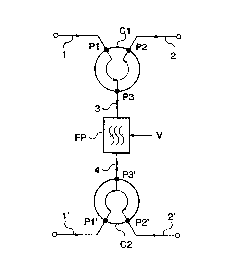Some of the information on this Web page has been provided by external sources. The Government of Canada is not responsible for the accuracy, reliability or currency of the information supplied by external sources. Users wishing to rely upon this information should consult directly with the source of the information. Content provided by external sources is not subject to official languages, privacy and accessibility requirements.
Any discrepancies in the text and image of the Claims and Abstract are due to differing posting times. Text of the Claims and Abstract are posted:
| (12) Patent: | (11) CA 2129778 |
|---|---|
| (54) English Title: | WAVELENGTH SELECTIVE OPTICAL SWITCH |
| (54) French Title: | COMMUTATEUR OPTIQUE A SELECTION DE LA LONGUEUR D'ONDE |
| Status: | Expired and beyond the Period of Reversal |
| (51) International Patent Classification (IPC): |
|
|---|---|
| (72) Inventors : |
|
| (73) Owners : |
|
| (71) Applicants : |
|
| (74) Agent: | SMART & BIGGAR LP |
| (74) Associate agent: | |
| (45) Issued: | 1997-09-02 |
| (22) Filed Date: | 1994-08-09 |
| (41) Open to Public Inspection: | 1995-02-11 |
| Examination requested: | 1994-08-09 |
| Availability of licence: | N/A |
| Dedicated to the Public: | N/A |
| (25) Language of filing: | English |
| Patent Cooperation Treaty (PCT): | No |
|---|
| (30) Application Priority Data: | ||||||
|---|---|---|---|---|---|---|
|
The device includes a first and a second optical circulator having an input portand an output port that are the inputs and the outputs of the switch, as well
as an optical bandpass filter placed between the two circulators and
connected with means for switching its state so that the filter either reflects
or transmits a given wavelength, thus allowing a carrier with this wavelength
at the input port of one of the circulators to reach the output port of the samecirculator or the output port of the other circulator.
e dispositif comprend un premier et un deuxième circulateurs ayant une entrée et une sortie qui sont les entrées et les sorties du commutateur, ainsi qu'un filtre passe-bande optique placé entre les deux circulateurs et connecté avec des moyens de commuter son état pour que le filtre réfléchisse ou émette une longueur d'onde donnée, ce qui permet à une porteuse ayant cette longueur d'onde à l'entrée d'un des circulateurs d'atteindre la sortie du même circulateur ou la sortie de l'autre circulateur.
Note: Claims are shown in the official language in which they were submitted.
Note: Descriptions are shown in the official language in which they were submitted.

2024-08-01:As part of the Next Generation Patents (NGP) transition, the Canadian Patents Database (CPD) now contains a more detailed Event History, which replicates the Event Log of our new back-office solution.
Please note that "Inactive:" events refers to events no longer in use in our new back-office solution.
For a clearer understanding of the status of the application/patent presented on this page, the site Disclaimer , as well as the definitions for Patent , Event History , Maintenance Fee and Payment History should be consulted.
| Description | Date |
|---|---|
| Inactive: IPC expired | 2013-01-01 |
| Letter Sent | 2007-01-10 |
| Inactive: Office letter | 2006-10-31 |
| Inactive: Office letter | 2006-10-06 |
| Time Limit for Reversal Expired | 2006-08-09 |
| Inactive: IPC from MCD | 2006-03-11 |
| Inactive: IPC from MCD | 2006-03-11 |
| Inactive: IPC from MCD | 2006-03-11 |
| Letter Sent | 2005-08-09 |
| Letter Sent | 2001-06-07 |
| Letter Sent | 2000-08-15 |
| Letter Sent | 2000-05-12 |
| Inactive: Multiple transfers | 2000-04-11 |
| Grant by Issuance | 1997-09-02 |
| Inactive: Status info is complete as of Log entry date | 1997-06-27 |
| Inactive: Application prosecuted on TS as of Log entry date | 1997-06-27 |
| Pre-grant | 1997-04-14 |
| Notice of Allowance is Issued | 1997-03-04 |
| Application Published (Open to Public Inspection) | 1995-02-11 |
| Request for Examination Requirements Determined Compliant | 1994-08-09 |
| All Requirements for Examination Determined Compliant | 1994-08-09 |
There is no abandonment history.
The last payment was received on 1997-06-17
Note : If the full payment has not been received on or before the date indicated, a further fee may be required which may be one of the following
Please refer to the CIPO Patent Fees web page to see all current fee amounts.
| Fee Type | Anniversary Year | Due Date | Paid Date |
|---|---|---|---|
| Final fee - standard | 1997-04-14 | ||
| MF (application, 3rd anniv.) - standard | 03 | 1997-08-11 | 1997-06-17 |
| MF (patent, 4th anniv.) - standard | 1998-08-10 | 1998-06-29 | |
| MF (patent, 5th anniv.) - standard | 1999-08-09 | 1999-07-07 | |
| Registration of a document | 2000-04-11 | ||
| MF (patent, 6th anniv.) - standard | 2000-08-09 | 2000-07-20 | |
| MF (patent, 7th anniv.) - standard | 2001-08-09 | 2000-08-01 | |
| Registration of a document | 2001-02-12 | ||
| MF (patent, 8th anniv.) - standard | 2002-08-09 | 2002-07-18 | |
| MF (patent, 9th anniv.) - standard | 2003-08-11 | 2003-07-21 | |
| MF (patent, 10th anniv.) - standard | 2004-08-09 | 2004-07-21 |
Note: Records showing the ownership history in alphabetical order.
| Current Owners on Record |
|---|
| AGILENT TECHNOLOGIES, INC. |
| Past Owners on Record |
|---|
| EMILIO VEZZONI |
| RICCARDO CALVANI |